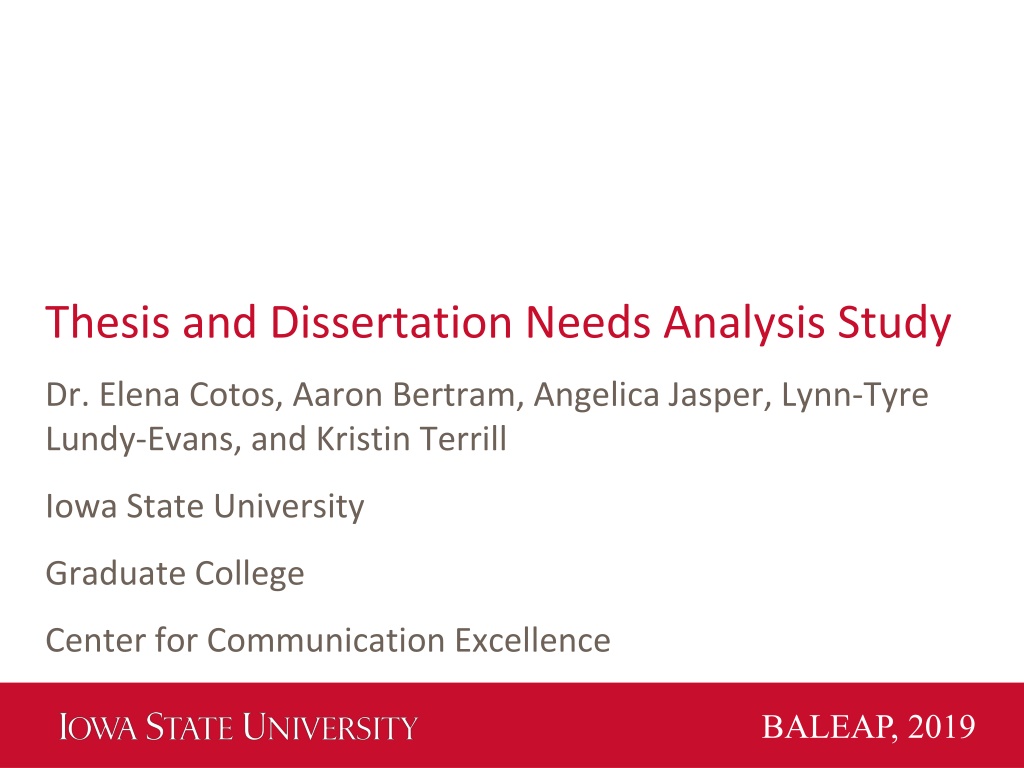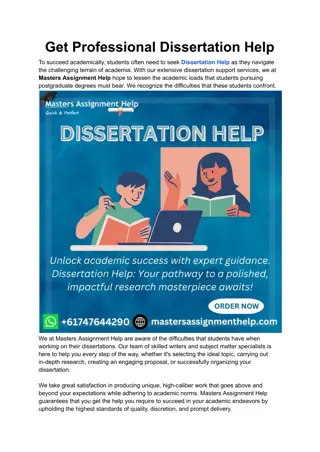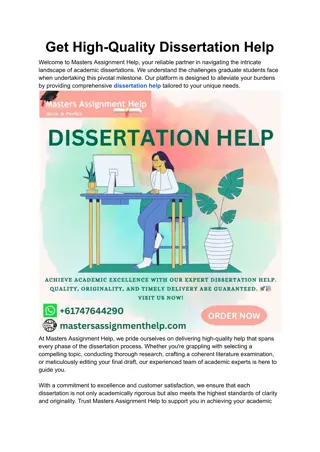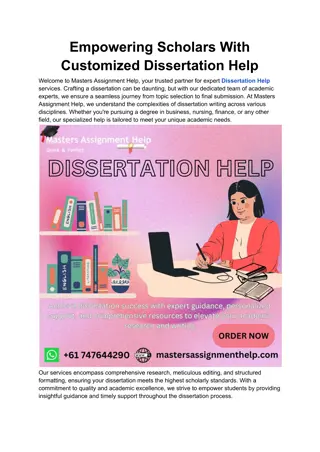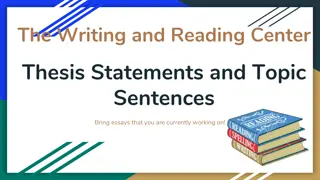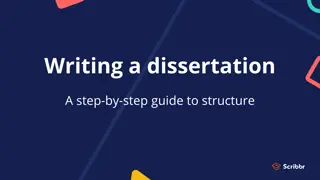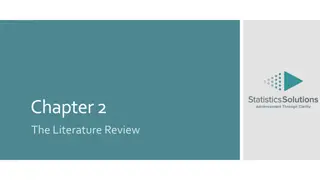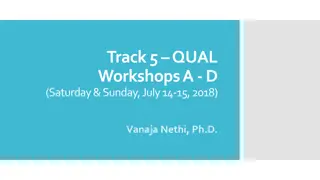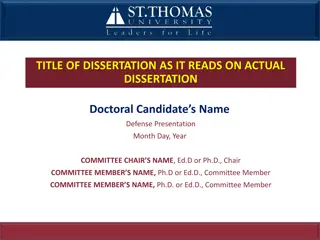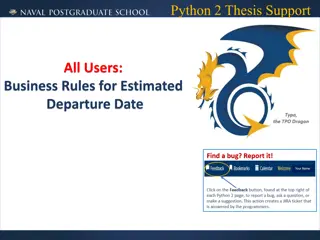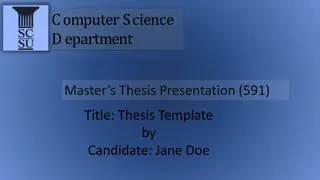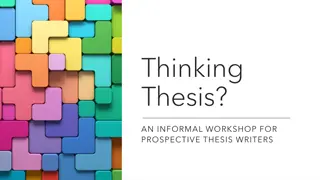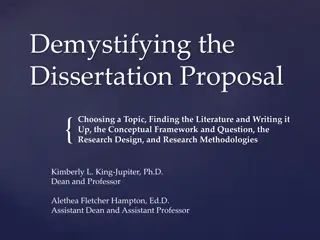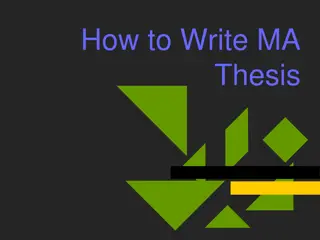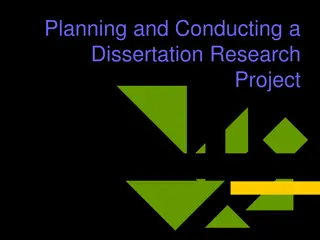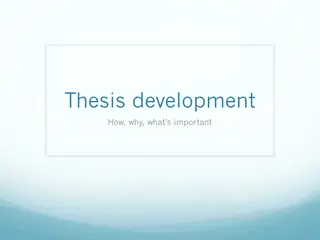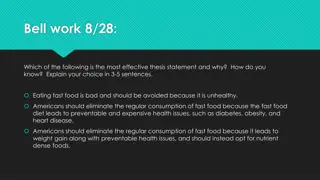Needs Analysis Strategies in Thesis and Dissertation Writing
This study delves into the needs analysis of thesis and dissertation writing, addressing concerns about writing quality and pedagogical materials development for graduate students. Approaching the topic from an English for Academic Purposes (EAP) perspective, key stages in ESP needs analysis, course design, evaluation, teaching-learning, and assessment are explored. The study identifies stakeholders, consults previous research, collects and analyzes data to determine syllabus items, and evaluates the course based on findings. Various information gathering procedures are employed to understand the structure and features of written texts in the context of ESP.
Uploaded on Oct 08, 2024 | 0 Views
Download Presentation

Please find below an Image/Link to download the presentation.
The content on the website is provided AS IS for your information and personal use only. It may not be sold, licensed, or shared on other websites without obtaining consent from the author. Download presentation by click this link. If you encounter any issues during the download, it is possible that the publisher has removed the file from their server.
E N D
Presentation Transcript
Thesis and Dissertation Needs Analysis Study Dr. Elena Cotos, Aaron Bertram, Angelica Jasper, Lynn-Tyre Lundy-Evans, and Kristin Terrill Iowa State University Graduate College Center for Communication Excellence BALEAP, 2019
Motivation Concerns about quality of published theses and dissertations specifically, writing quality Opportunity to develop pedagogical materials for graduate students Approach: EAP (English for Academic Purposes)
Key Stages in English for Specific Purposes Needs analysis Course design Evaluation Teaching- learning Assessment Dudley-Evans & St. John, 1998
Key Stages in English for Specific Purposes Needs analysis Course design Evaluation Teaching- learning Assessment Dudley-Evans & St. John, 1998
Identify stakeholders Consult previous NA and research in the area Devise best methods of collecting data (triangulate from multiple sources, situations, methods) Collect and analyze data (needs, wants, necessities, analysis of specialist discourse) Translate findings into list of communicative events Determine syllabus items based on the above Evaluate course
Needs Analysis What kinds of needs? What is the viewpoint? What is the best analysis strategy?
Needs Analysis What kinds of needs? objective/perceived; product- oriented What is the viewpoint? discrepancy What is the best analysis strategy? present-situation analysis
Information gathering procedures Need type = objective/perceived; product oriented Viewpoint = discrepancy Analysis strategy = present situation analysis Written data analysis (a.k.a. text analysis) seeks to understand the structure and other features of written texts collected as writing samples from the particular ESP (Brown, 2016, p. 67).
Information gathering procedures Need type = objective/perceived; product oriented Viewpoint = discrepancy Analysis strategy = present situation analysis Written data analysis (a.k.a. text analysis) seeks to understand the structure and other features of written texts collected as writing samples from the particular ESP (Brown, 2016, p. 67).
Method Mixed methods - Exploratory Design (Mackey & Gass, 2016, p. 281-282) QUALitative data and results QUANTitative data and results Interpretation
Research Questions What discrepancy patterns can be observed in ISU thesis and dissertation samples? Student status (masters/doctoral) Discipline Document structure
Research Questions What discrepancy patterns can be observed in ISU thesis and dissertation samples? Student status (masters/doctoral) Discipline Document structure Note: Generally in the United States, Masters students write theses Doctoral students write dissertations.
Research Questions What discrepancy patterns can be observed in ISU thesis and dissertation samples? Student status (masters/doctoral) Discipline Document structure
Identify stakeholders Consult previous NA and research in the area Devise best methods of collecting data (triangulate from multiple sources, situations, methods) Collect and analyze data (needs, wants, necessities, analysis of specialist discourse) Translate findings into list of communicative events Determine syllabus items based on the above Evaluate course
Sample collection List of ISU graduates (2015-2017) Sample included 10% of theses and dissertations from each department (one document from each department with <10 graduates) IMRD/C structures only (no creative component papers included) Randomly selected 1 section from each paper 10% page sample from each section (randomly selected pages using Excel spreadsheet tool)
Sample collection List of ISU graduates (2015-2017) Sample included 10% of theses and dissertations from each department (one document from each department with <10 graduates) IMRD/C structures only (no creative component papers included) Randomly selected 1 section from each paper 10% page sample from each section (randomly selected pages using Excel spreadsheet tool) Introduction Methods Results Discussion/conclusion
Sample collection List of ISU graduates (2015-2017) Sample included 10% of theses and dissertations from each department (one document from each department with <10 graduates) IMRD/C structures only (no creative component papers included) Randomly selected 1 section from each paper 10% page sample from each section (randomly selected pages using Excel spreadsheet tool)
Qualitative analysis methods Framework provided by experienced EAP instructor Rating scale developed for quantifying findings Four trained coders: Applied linguistics and technology Mechanical engineering Gerontology/HCI Supply chain & information systems
Qualitative analysis methods Framework provided by experienced EAP instructor Rating scale developed for quantifying findings Four trained coders: Applied linguistics and technology Mechanical engineering Gerontology/HCI Supply chain & information systems All raters were experienced EAP scholars or practitioners
Qualitative Framework Local Global Accuracy of language use Grammar Lexis Overlapping concerns Communication effectiveness Inappropriate or lacking transition Coherence/cohesion Inappropriate or lacking logical development Inappropriate or unclear expression; clarity of idea Mechanics Punctuation Inconsistency in citation style Spelling and capitalization Formatting Conformity with genre conventions Ineffective or lacking argumentation Content integration
Results (quantitative) Student status (masters/doctoral) Discipline Document structure
Quantitative Results Disciplines with most frequent concern: Art and Visual Culture (1 thesis) and Graphic Design (2 theses) had high rates of frequent/severe concerns. Computer Science (3 theses/1diss), Genetics Development and Cell Biology (1 thesis), and Materials Science and Engineering (1 thesis/1diss) had moderate rates of frequent/severe concerns and moderate rates of rare/minor concerns.
Discussion Need for support for all levels of graduate students Discipline-specific Sub-genre specific Local and global
Limitations and Future Research Next steps: translate findings into list of communicative events Product-oriented; objective/perceived needs Process? Subjective/felt needs? Discipline-specific needs?
Key Stages in English for Specific Purposes Needs analysis Course design Evaluation Teaching- learning Assessment Dudley-Evans & St. John, 1998
Thesis and Dissertation - Academic Genre Known issues Semi-occluded genre High-stakes First publication Genre ecology (Erickson, 2000) Statement of purpose Research article CV Research statement/research agenda
References Basturkmen, H. (2010). Developing Courses in English for Specific Purposes. New York: NY: Palgrave Macmillan. Brown, J. D. (1995). The elements of language curriculum: A systematic approach to program development. Boston, MA: Heinle & Heinle Publishers. Brown, J. D. (2016). Introducing Needs Analysis and English for Specific Purposes. Oxford: Routledge. Charles, M. (2018). Corpus-assisted editing for doctoral students: More than just concordancing. Journal of English for Academic Purposes, 36, p. 15-25. Dudley-Evans, T., & St. John, M. (1998). Developments in ESP : A multi-disciplinary approach. Cambridge, U.K.; New York: Cambridge University Press. Evans, M. J. St. J. (Cambridge language teaching library). Cambridge, U. K.; New York: Cambridge University Press. Erickson, T. (2000). Making sense of computer-mediated communication (CMC): Conversations as genres, CMC systems as genre ecologies. In R. H. Sprague, Jr. (ed.). 33rd Hawaii International Conference on System Sciences. Maui: IEEE Computer Society Press. Mackey, A. & Gass, M. (2016). Second Language Research: Methodology and Design. New York: Routledge.
Thank you. I welcome your questions and feedback.
